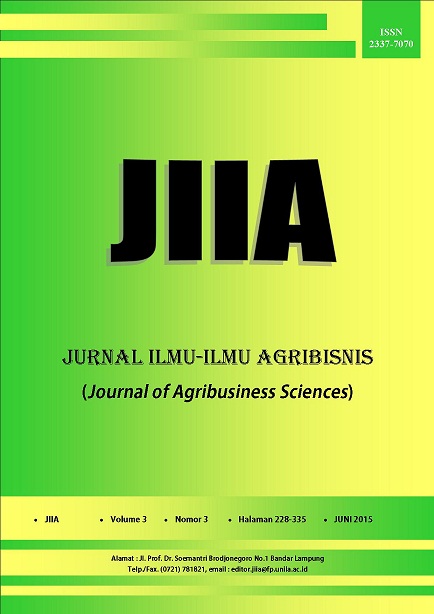SIKAP DAN POLA PEMBELIAN BUMBU INSTAN KEMASAN OLEH KONSUMEN RUMAH TANGGA DI BANDAR LAMPUNG
DOI:
https://doi.org/10.23960/jiia.v3i3.1059 Abstract View: 1812
Abstract View: 1812
Abstract
The purpose of this research were to determine the household consumer attitudes, purchasing patterns, and the dominant affecting factor of the instant seasoning purchase. This research was conducted in sub-district of Kemiling and Rajabasa of Bandar Lampung City. The number of 67 households was drawn by the method of group stages sampling. The research data was analyzed by Fishbein and principal component analysis. The result showed that the pattern of instant seasoning purchases by consumers in Bandar Lampung as follows: the average purchase frequency of instant seasoning was twice per month, 3-4 sachet purchase amount, and the type of instant seasoning most preferred by consumers were racik tempe and fried rice. The most preferred and trusted attributes by consumers were the ease of obtaining the product, expired date information and the taste. Based on the score of attitude attributes on instant seasoning, the brand of Indofood and ease of obtaining the product got the highest score, followed by the attribute expiration information and the taste. The dominant factor on influencing purchasing decisions of seasoning was formed by four main components (factors) based on the value of the loading factors. The first component (information) consists of expiration information, others’ influences and composition of the product. The second component (product) consists of the influence of taste, promotions and prices. The third component (product suitability) consists of variables brand and conformity with the type of cuisine. The fourth component (ease of obtaining the product) consists of variable ease of obtaining the product.
Key words: attitude, factor analysis, instant seasoning
Downloads
Downloads
Published
How to Cite
Issue
Section
License
Authors who publish with this journal agree to the following terms:
Authors retain copyright and grant the journal right of first publication with the work simultaneously licensed under a Creative Commons Attribution License that allows others to share the work with an acknowledgement of the work's authorship and initial publication in this journal.
Authors are able to enter into separate, additional contractual arrangements for the non-exclusive distribution of the journal's published version of the work (e.g., post it to an institutional repository or publish it in a book), with an acknowledgement of its initial publication in this journal.
Authors are permitted and encouraged to post their work online (e.g., in institutional repositories or on their website) prior to and during the submission process, as it can lead to productive exchanges, as well as earlier and greater citation of published work (See The Effect of Open Access).














